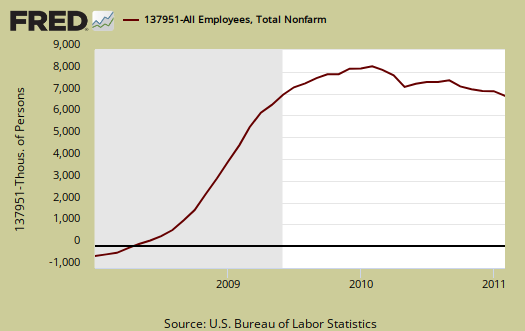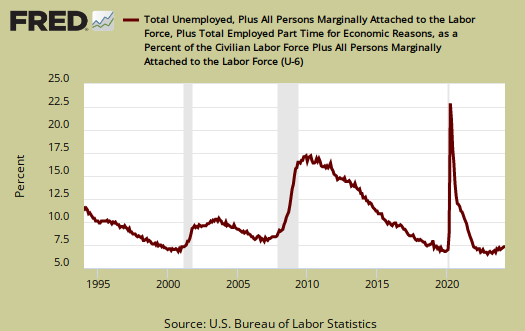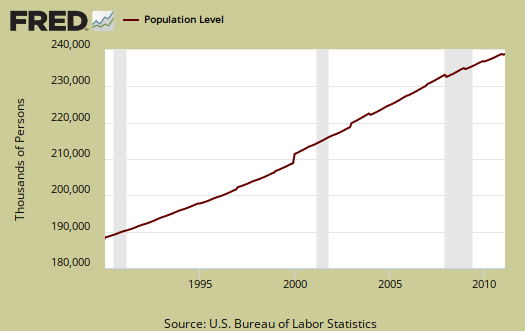The February 2011 monthly unemployment figures are out. The official unemployment rate decreased to 8.9% and the total jobs gained were 192,000, with 15,500 of those jobs being private temporary. Total private jobs came in at +222,000 with government jobs dropping -30,000.

Those added to not in the labor force was +87,000. The labor force participation rate was unchanged, 64.2%, from last month. Those added to the civilian labor force was +60,000 and to the noncivilian population, +147,000. This is the lowest labor participation rate since March 1984. U6, or the broader unemployment measurement, dropped -0.2% to 15.9%, but also due to not counting people.
Below is the nonfarm payroll, the total number of jobs, seasonally adjusted. Since the start of the great recession, declared by the NBER to be December 2007, the United States has officially lost 7.47 million jobs. That does not take into account population growth.

Below is a running tally of how many official jobs permanently lost since the official start of this past recession (recall the private NBER has declared the recession over!). This is a horrific tally and notice this isn't taking into account increased population growth, which implies the United States needs to create at least 10.5 million jobs to break even from December 2007.

We get a new graph of the alternative unemployment measurement, U-6, posted below. Here you can see the incredible increase in comparison to the beginning of this broader unemployment measurement.

How can the unemployment rate decrease so dramatically when not enough jobs were added to even cover population growth? Because the people the BLS counts dramatically decreased, they didn't disappear, but are re-categorized as not in the labor force.
The civilian labor force increased by +147,000. Of those still in the civilian labor force, employed, increased by 250,000 in February, yet those unemployed dropped by -190,000. Those not in the labor force increased by +87,000 in a month. What we see here are people simply dropping out of the count and less people entered the labor force...looking for work, officially.
The civilian non-institutional population are those 16 years or older not locked up somewhere or not in the military or so sick and disabled they are in a nursing home and so on.
The civilian non-institutional population rose by 147,000 last month. The civilian population now stands at 238,851,000. Not in the labor force are those of the civilian non-institutional population who are not counted as looking for work or having a job. Yet those not in the labor force stands as a horrifying 85,605,000, or 36% of the non-institutional civilian population. An equally horrific 13,673,000 people of the official tally are out looking for work.

The increasingly low labor participation rate is now at 64.2%. If we go back to December 2007, the labor participation rate was 66%. The highest civilian labor participation rate was in January 2000, at 67.3%. What this means is there are almost 4.3 million people not be accounted for in the official unemployment rate who probably need a job and can't find one.

The employment to population ratio is now 58.4% also at record level lows. This isn't a structural change, such as all families decided to have a stay at home caretaker, or magically a host of people could retire early, this is people dropping out of the count.
These numbers are important because unemployment is a ratio, percentage or during a limited time period, the number of people actively looking for a job and counted. Many people are not counted in the official unemployment statistics, due to definitions, but obviously when one has more potential workers and less jobs, that metric doesn't bode well for America.

Below is the graph of the civilian non-institutional population, which is the largest super-set of the potential labor force, larger than the civilian workforce, due to those who are not looking for work, retired and so on being counted in this figure. Except for some statistical adjustments, the monthly rate of change in civilian non-institutional population is a reasonably constant 1% population growth. This is why one must create jobs greater than the constant rate of jobs lost. There are more people to employ. Unemployment is a percentage, a ratio.
The BLS unemployment report counts foreign temporary guest workers as well as illegal immigrants in their U.S. labor force statistics.

One needs at least 175,000 and some estimate up to 375,000 permanent full time jobs, added each month just to keep pace with U.S. civilian workforce population growth. That's not general population, that's the group needing a job.
While this report is the best showing we've seen in a while, it still isn't enough. Don't let the press or the politicians trying to blind you into thinking America doesn't have a jobs crisis.
Subject Meta:
Forum Categories:
| Attachment | Size |
|---|---|
| 253.89 KB |

breaking up the overview
I'll be writing more details on this report. As everyone knows the BLS now is a major puzzle to see where the adjustments are, if a mon-to-mon comparison has any validity or clue in to what's going on...
but bottom line, while it's great to see 192,000 jobs, I frankly expected much more from other economic reports....
and to make matters worse, it's doubtful this was even enough to keep up with population.
So, we have all sorts of politicians acting like this crisis is over, not even close! Not even a dent really in the jobs crisis.
I'll write up more details in another post after I can dig them out.
Looking Forward to Reading More About This
So if unemployment has decreased by about 10%, the average person would think that the number of unemployed people has decreased by about 10% too.
But that isn't the case, is it?
All this is so confusing.
And how much is employment improving for the long-term unemployed, the ones who need a job th most?
It kills me when I read that employment of immigrants has been increasing. It's a disgrace that no major economist or politician has called for a moratorium on immigration of any kind. There's no reason to be admitting the siblings and parents of prior immigrants by the hundreds of thousands each year "just to be nice" as we've been doing for decades.
I could care less about extended family reunification when there's so many people out of work. And what about all those temporary workers that we don't need either?
Simply insane. And that we all put up with it is even worse. Oh yeah and I'm a racist for saying all this too, according to the people whose tender consciences compel them to support giving away other Americans' jobs to people from overseas. I'm waiting for the day these morally superior folks volunteer to give away their own jobs to a needy and worthy immigrant.
It really is
I believe the unemployment rate is becoming more meaningless primarily because all of this is based on non-institutional civilian population and I think that's a skewed metric. I think U-6 is becoming more meaningful. The numbers at this point which have more validity are payrolls, or the number of jobs. The survey is more robust to tally these up.
New Labor Force Entrants
I see this figure was 147,000 for February.
I can't tell you how many times I've read that the labor force grows by about 125,000 each month.
Is 147,000 a blip or is this higher number the more typical and "new normal" figure?
that's noninstitionalized population
147k are all of the people not locked up, not serving in the military, not in a nursing home, in a mental hospital and so on who are over age 16. That includes retirees.
It's actually low this month, more around 200k a month. the labor force grew by 60k this month. that said, it's all about the participation rate, which is very low.
Labor participation rate that low means there are assuredly people who want and need a job who have given up and are not counted anywhere.
Another problem is the civilian non-institutional population is derived from the 2000 Census, which is now 11 years old as a base. Then they extrapolate out the monthly growth, but using 2000 as a base I've yet to understand why they would do that..
for if non-institional civilian population is way off, all other ratios are way off.